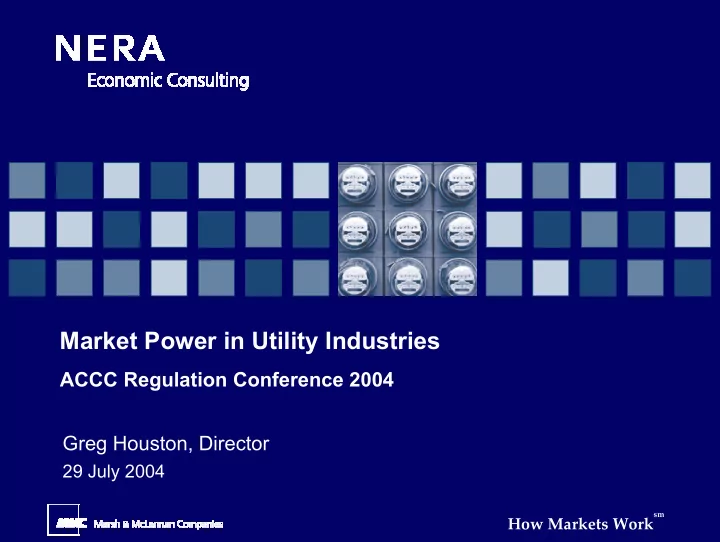

Market Power in Utility Industries ACCC Regulation Conference 2004 Greg Houston, Director 29 July 2004 sm How Markets Work
What’s Special About Utilities? � High fixed costs � Low marginal costs often below average costs – � Not a unique problem Microsoft – airlines – concrete masonry products – intellectual property – � If marginal cost equalled average cost in all industries at all times market power problems would not arise! sm 2 How Markets Work
Electricity Generation - Exercise of Market Power � Classic exercise of market power by a generator withdraw capacity – market price increases – the increased price for other units’ output more than makes up – for the loss on the withdrawn capacity � To make this work, a generator must be ‘big’ relative to the size of the market � Most effective in ‘peak’ times when the supply curve is steep sm 3 How Markets Work
Do High Prices at Peak Times Imply Market Power? � Not necessarily many potential explanations exist – � In an efficient market the spot price must reflect the interaction of supply and demand the efficient price depends upon whether supply is or is likely – to be constrained during a dispatch period sm 4 How Markets Work
Competitive Electricity Market - Unconstrained Supply � When demand is less than total available capacity the spot price is determined by the highest cost generator � Price should settle at or near marginal generation cost S Price ($) These customers choose to not consume Market Price D Market Clearing Q Quantity (MW) � Infra-marginal generators earn above marginal cost, so contributing to fixed costs sm 5 How Markets Work
Competitive Electricity Market - Constrained Supply � As demand approaches maximum capacity the price must increase until some customers reduce demand (or, worse, blackouts may occur) � Absent demand side bidding the regulator must set this price, designated the value of lost load (VOLL) S Price ($) These customers choose to not consume Market Price = VOLL D Market Clearing Q Quantity (MW) sm 6 How Markets Work
Competitive Electricity Market Spot Prices � At any time, the expected spot price equals: [(1 – LOLP) x system marginal cost] + [LOLP x VOLL] + supply side dominant demand side dominant Sum of all spot price outcomes depends on the supply/demand balance sm 7 How Markets Work
Prices Must Increase During Peak Times � Prices above marginal supply cost during peak periods prevent blackouts – allow generators to recover investment costs – provide investment signals – � Transient price increases may simply indicate scarcity rents which are a necessary feature of competitive electricity markets ‘Not all high prices are due to market power … even in a perfectly competitive market, prices should rise above marginal cost when capacity is tight, to the level that the last customer left buying is willing to pay’ Hunt, S, Making Competition Work in Electricity, Wiley, 2002, p89 sm 8 How Markets Work
Tests for Market Power using Short Term Prices are Problematic � Market power is ‘the ability of a firm to raise prices above the supply cost without rivals taking away customers in due time’ Queensland Wire (1989) 167 CLR 177 at 189 � Short-term tests are rarely capable of detecting market power significant price increases during peak periods – monopoly rents or scarcity rents? � aggressive price decreases following new entry – predatory pricing or meeting competition? � sm 9 How Markets Work
Tests for Market Power using Short Term Prices are Problematic ‘I do not accept that such inter-temporal market power reflects more than an intermittent phenomenon nor does it reflect a long run phenomenon having regard to the possibilities of new entry through additional generation capacity and the upgrade of interconnectors between regions. It does not amount to an ongoing ability to price without constraint from competition’ Justice French , AGL v ACCC, para 493 sm 10 How Markets Work
So How Should Market Power be Analysed? Assessing whether there is ‘an ongoing ability to price without constraint from competition’ requires � a focus on genuine barriers to entry, as the cause of market power � long term price cost tests (HNET, LRMC), as evidence of the exercise of market power sm 11 How Markets Work
sm sm 12 How Markets Work How Markets Work
Recommend
More recommend